Busan, Korea’s vibrant port city, has long been a favourite for domestic and international tourists with its mix of modern attractions and coastal beauty. While many consider it a stopover destination as part of their main holiday itinerary, Busan and its surrounding regions offer so much more than Haeundae Beach and Jagalchi Market. There’s a whole world waiting to be explored, so join us as we dive into the lesser-known destinations, scenic landscapes, healing experiences, and rich traditions of Ulsan and the Gyeongnam Province.
|
Gyeongnam Province, with its serene retreats, cultural landmarks, and stunning landscapes, offers the perfect escape from the bustling energy of Korea’s more well-known cities. Whether you’re looking to rejuvenate in Sancheong’s tranquil surroundings, dive into cinematic history in Hapcheon, find peace in Hadong’s nature, or explore the cultural treasures of Gimhae, Gyeongnam has something for every kind of traveller. Meanwhile, Ulsan is a dynamic city, offering a blend of industrial innovation and natural beauty. Book your flight to Busan, the ideal gateway to this beautiful region, and get ready to experience these underrated destinations that truly capture the essence of Korea. Trust us, Gyeongnam is the perfect blend of relaxation, adventure, and discovery! |
Getting to Busan, Ulsan and Gyeongnam Province
Getting to Busan is easy and convenient, with 11 weekly flights direct from Singapore to Gimhae Airport via major airlines like Singapore Airlines and Jeju Air (we flew Jeju Air!). From there, you’re perfectly positioned to delve into the hidden charms of the province.
Also read: 26 Best Things to Do in & Near Busan
Fun fact: Jeju Air offers vegan-friendly meals, making it a convenient option for Muslim or vegan travellers seeking a worry-free dining experience.
Sancheong: A healing destination surrounded by nature
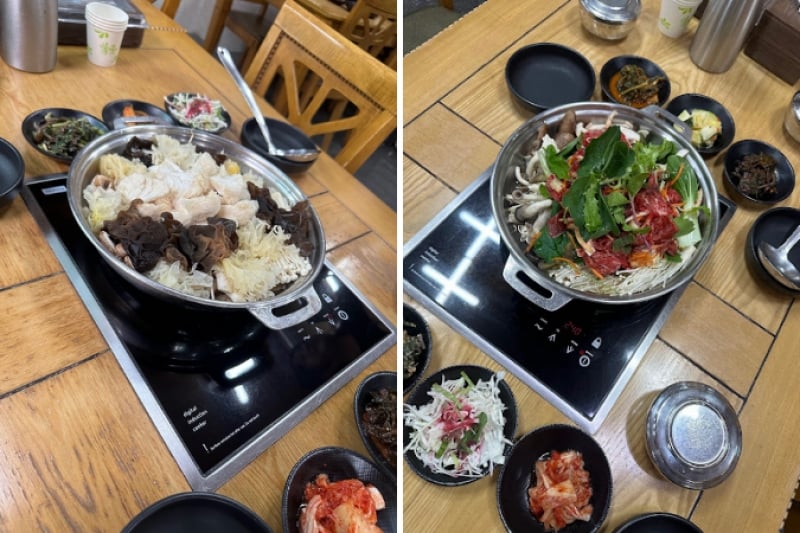
Upon landing, we hopped onto a bus that whisked us straight to Sancheong. We were greeted with a quintessential Korean welcome: a choice of delightful medicinal herb and mushroom or beef hotpot at the Medicinal Herb & Mushroom Restaurant in Donguibogam Village. The deerhip and antelope horn mushrooms, unique varieties that only grow in the local mountains, gave the dish a regional touch!
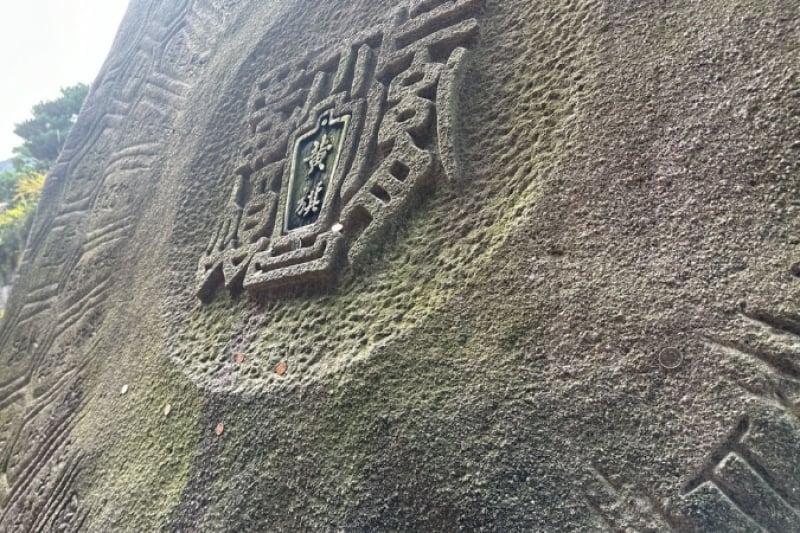
After filling our bellies, we headed for a Gibawi experience, where we channelled positive energy from the ancient rocks around the village. These rocks are believed to have healing properties that enhance well-being. Some visitors even stuff coins between the rocks in hopes that their wishes will be granted with this offering.
We visited the World Traditional Medicine Expo, where we learned about the various ways traditional Korean medicine (TKM) can enhance our health. We were introduced to foods that are considered beneficial like ginseng, which is known for its vitality-boosting properties.
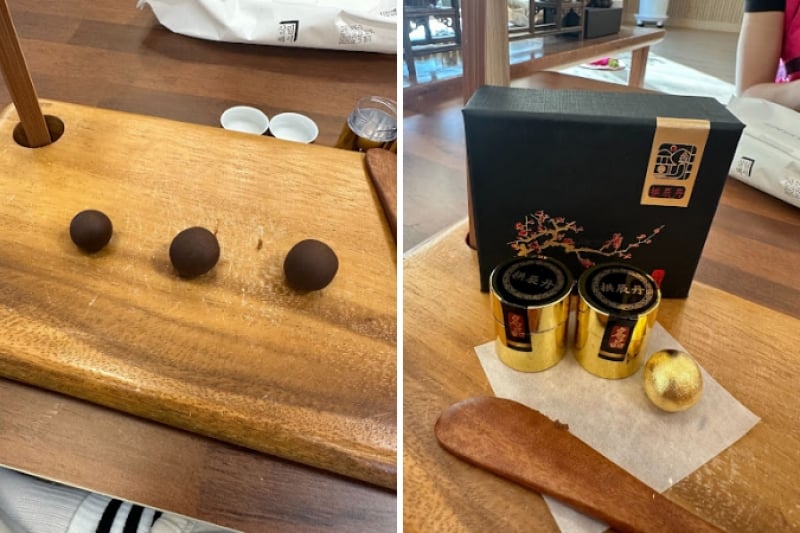
Continuing our herbal journey, we had the chance to practise what we’d just learned by making and trying gongjidan, a traditional energy-boosting pill. We kneaded the pills together and wrapped them in gold foil. While the taste was undeniably bitter, the health benefits and impressive one-year shelf life make it a prized gift. Plus, the elegant packaging adds an extra touch of charm!
Fun fact: BTS members incorporate gongjidan into their daily routine too, maybe that’ll convince you to give these bitter pills a try!
Next on our itinerary was a moxibustion experience, where we were guided by the principle that a cool mind and a warm stomach are key to well-being. Simply put, moxibustion involves burning mugwort leaves, which invigorate the blood and promote the flow of chi. As the moxibustion tool was gently placed on our stomachs, we felt a soothing warmth radiate through our bodies, helping to expel excess heat and restore balance. The 20-minute session was not only therapeutic but deeply comforting, leaving us feeling relaxed and revitalised.
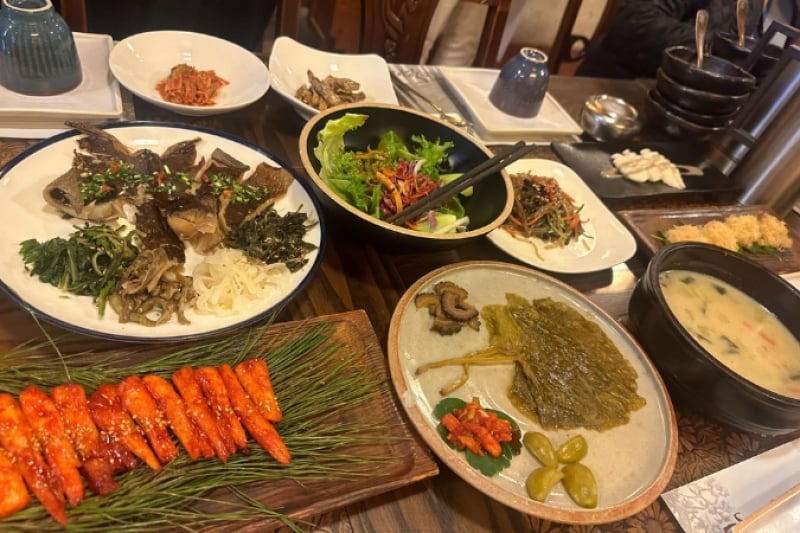
All this relaxation and healing worked up quite an appetite, so we headed to Dongui Yakseon Gwan, where we were treated to hanjeongsik, a traditional full-course meal. It featured an impressive array of banchan, the many small side dishes that accompany Korean meals, with each one offering a burst of flavour.
After our delightful meal, we checked into the spacious Sancheong Oriental Medicine Family Hotel, where we retired for the night in comfort.
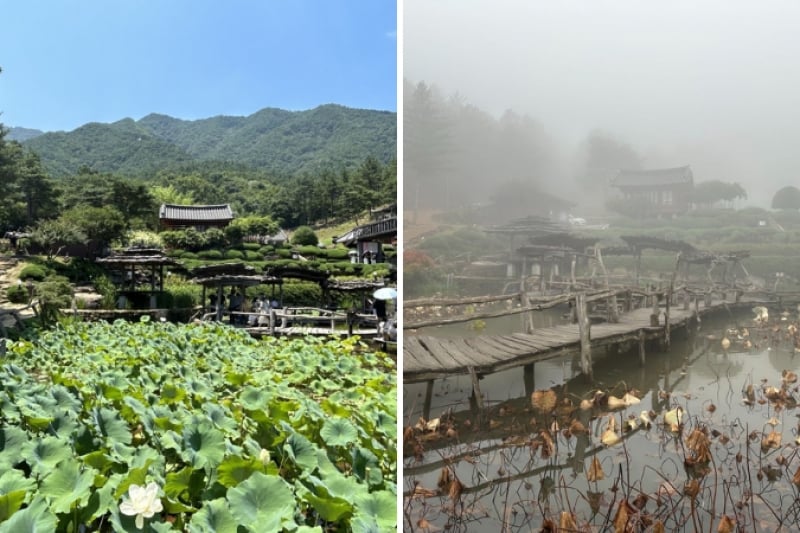
Lotus flowers during summer (L) and autumn (R)
The next morning, we awoke to a misty, tranquil landscape that felt like it had been plucked straight from the scenes of a cinematic masterpiece. We then made our way to our final stop in Sancheong, the peaceful Suseonsa Temple. This temple was a small but beautiful sanctuary nestled in the grand Jirisan Mountain.
Hapcheon: A cinematic journey through Korea’s film history
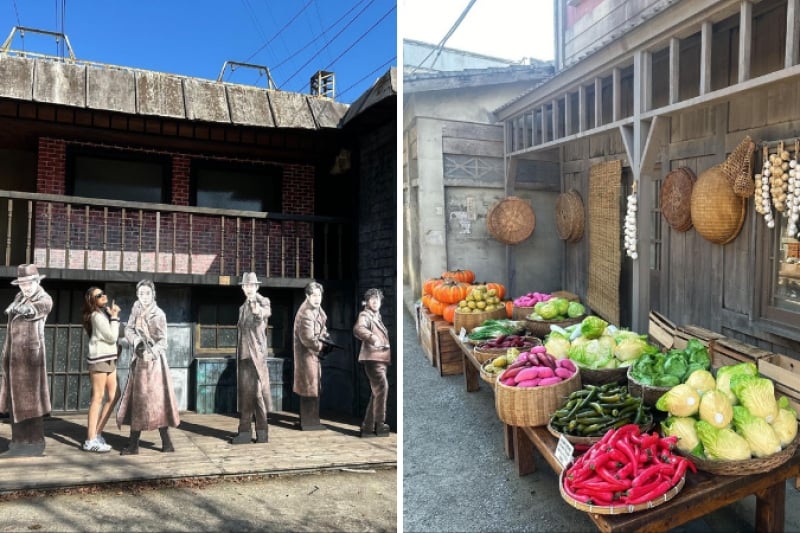
Leaving the healing Sancheong behind, we headed to Hapcheon’s must-visit spot for K-pop and K-drama lovers alike, the Hapcheon Film Park. This park has been used as a filming location for over 190 dramas, movies, and music videos, all set between the 1920s and 1980s. Wander through the different sets or explore the neighbouring bonsai park. Make sure you get your cameras ready, as every backdrop is perfect for the ‘gram!
Fun fact: You’ll even find Gong Yoo’s handprint here, it’s probably the closest you can get to “holding hands” with the star.
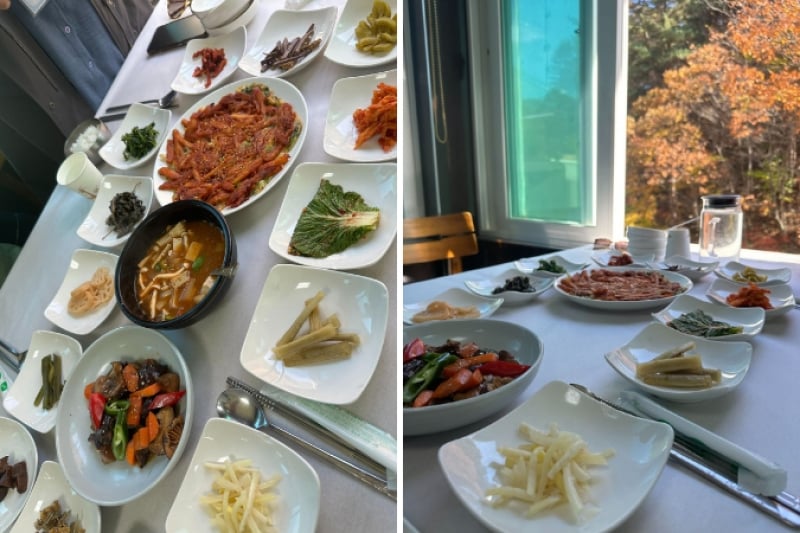
Afterwards, we had another generous round of hanjeongsik at Gombawoo Restaurant where we were treated to grilled deodeok (ginseng root)! The crunchy deodeok is a must-try! It was served with a sweet sauce that masked the slightly bitter taste. Adding to the experience, the restaurant offered stunning views of the vibrant autumn scenery. As we dined, the warm hues of red, orange, and gold leaves outside created a picturesque backdrop that made the meal all the more memorable.
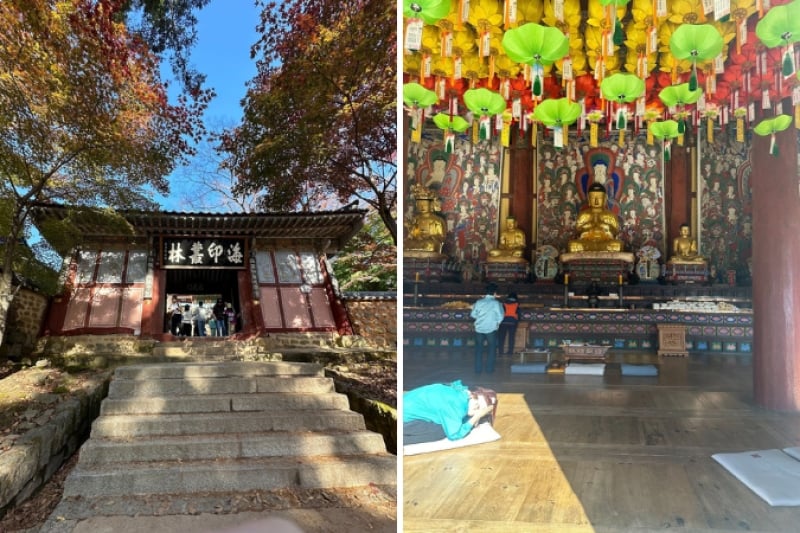
Nestled in Gaya Mountain, the UNESCO World Heritage Site and one of Korea’s three largest temples, Haeinsa Temple, was our last stop in Hapcheon. Visitors can donate rice, candles and other essentials but here’s the catch — you need to carry your offering up to the main Buddha yourself! Climb up 108 steps to reach the main Buddha, a symbolic journey reflecting the 108 earthly desires in Buddhist teachings.
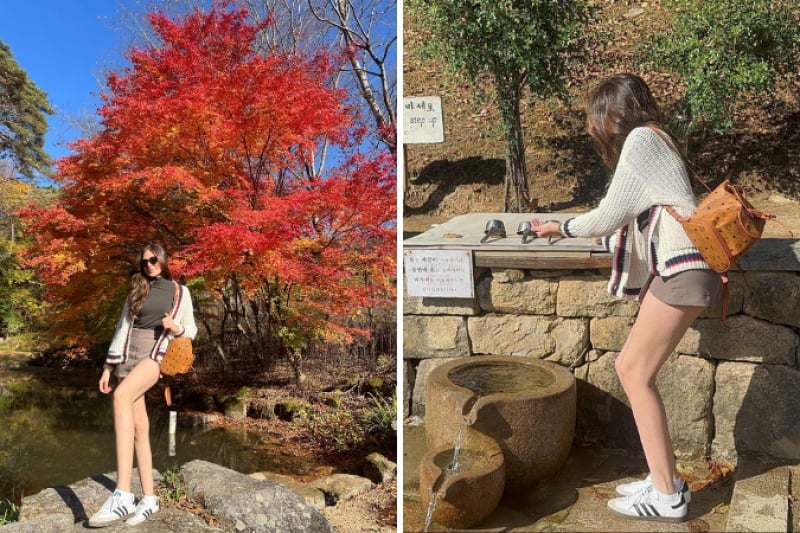
There are beautiful trees (L) and a fresh water well outside the temple
TripZilla Tip: Haeinsa Temple is wheelchair-accessible, with ramps ensuring ease of access for the elderly and PWDs.
Hadong: Tranquility amidst tea and scenic views
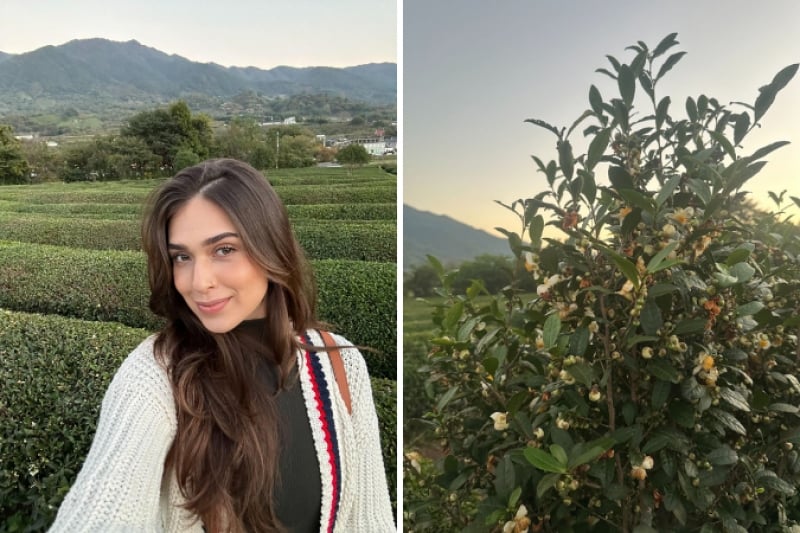
Just a short distance from Hapcheon lies Hadong, a region known for its lush green tea plantations. Hadong’s tea is renowned for its subtle, earthy flavour, and a visit to the Maem Jedawon offers visitors the opportunity to savour high-quality teas such as green tea which has been fermented for five years and Ceylon black tea.
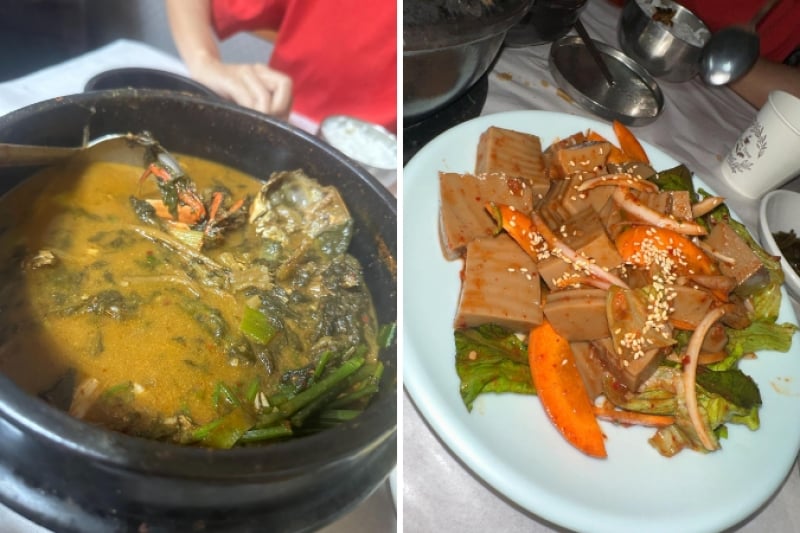 Hadong is also famous for its delicious marsh clam and hairy crab soup, a must-try dish for those visiting the region. We tried the flavourful broth at Hyesung Restaurant and it did not disappoint.
Hadong is also famous for its delicious marsh clam and hairy crab soup, a must-try dish for those visiting the region. We tried the flavourful broth at Hyesung Restaurant and it did not disappoint.
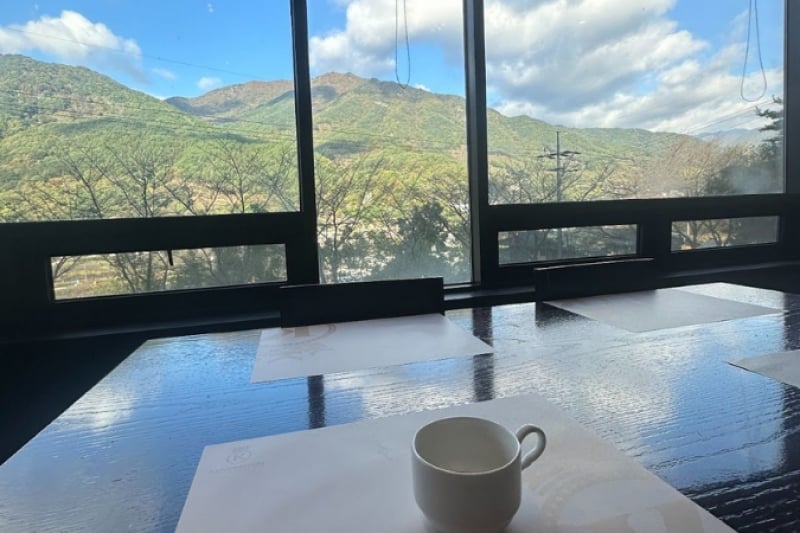
After a day of travelling, we turned in for the night at Kensington Resort Hadong. We enjoyed the comfort of heated floors, stunning mountain views and an intercontinental breakfast the next morning.
Ulsan: The industrial city with hidden charms
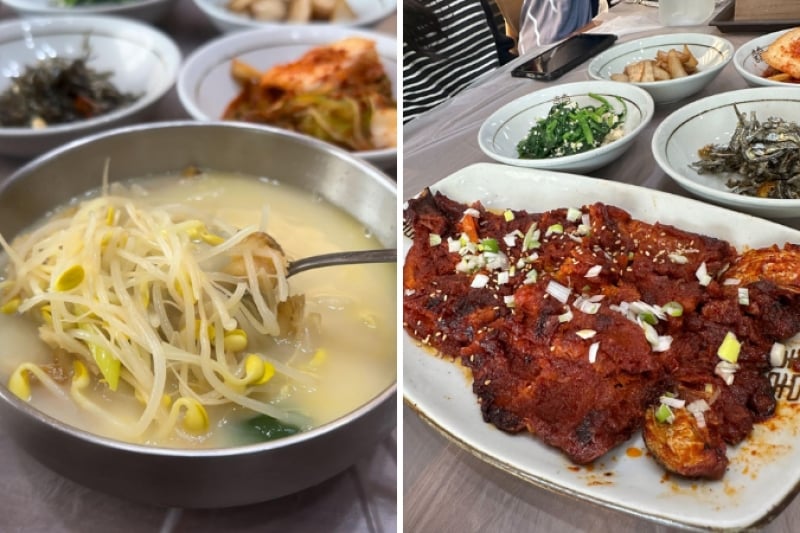
After a hearty breakfast, we made our way to Ulsan, where we tried grilled pollack and dried pollack soup with a variety of delectable side dishes at Jinburyeong Gamjabau. The flavours were simple yet satisfying, offering a delightful introduction to Ulsan’s cuisine.
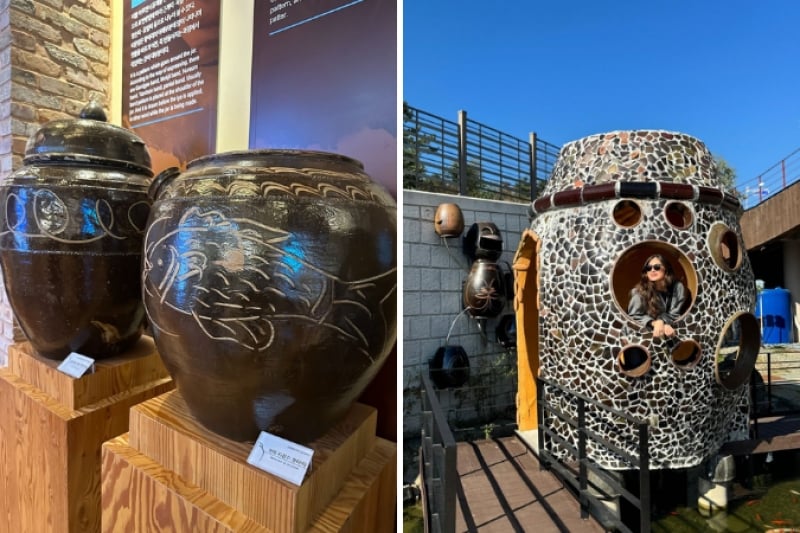
While Ulsan is primarily known for its role as an industrial powerhouse, it also boasts a variety of cultural and natural attractions. One such gem is the Ulsan Onggi Museum, where we saw an impressive display of patterned onggi.
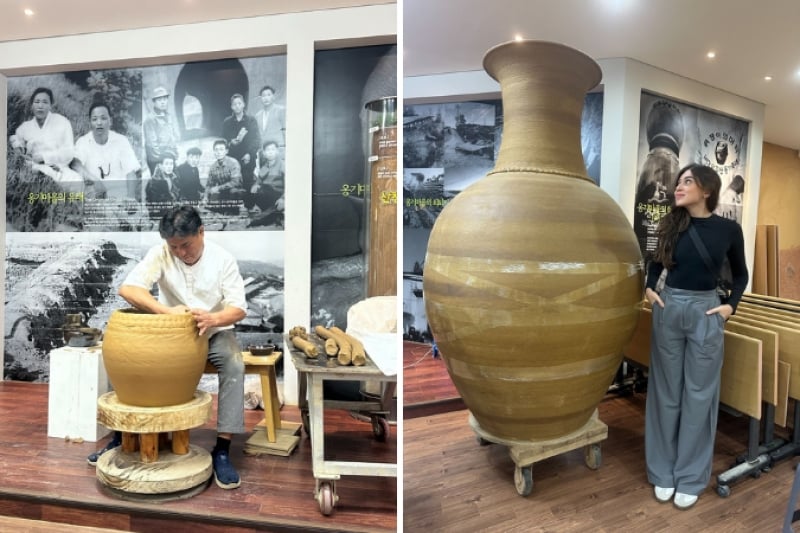
They crafted this giant onggi without considering whether it could actually be moved out of the room to be baked in the kiln (R)
Just a short drive away was the Ulju Oegosan Onggi Village, where we learnt about the time-consuming process of pottery making. Creating a simple piece of pottery is a meticulous process that takes approximately two weeks. This includes shaping the clay, drying it, adding colour, and finally baking it in a kiln. The baking stage is particularly delicate, as around 20% of pieces can break due to the intensity of the fire. To prevent this, the pottery is baked slowly and carefully, maintaining an ideal temperature of about 1230°C to ensure durability and quality. We also watched artisans handcraft traditional onggi—large ceramic jars used for storing fermented foods like kimchi.
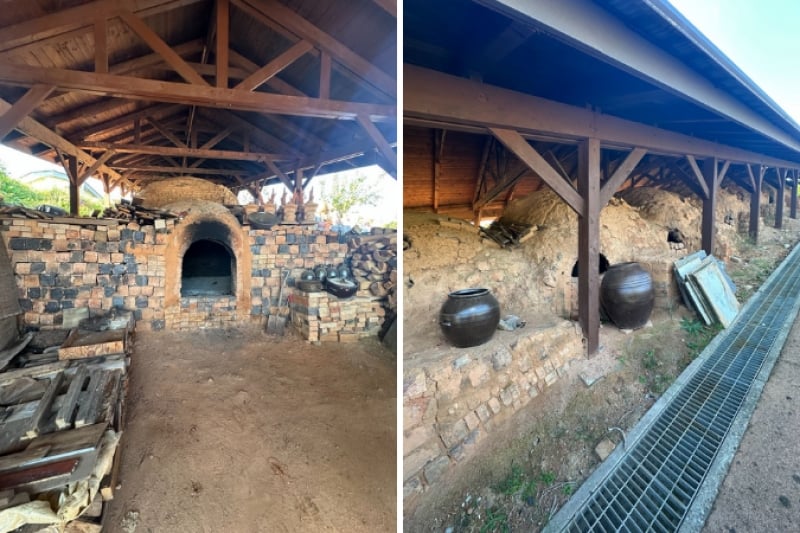
Traditional kilns, like noborigama (climbing kilns), are built on slopes to use natural heat circulation. This design ensures even heat distribution, maintains high temperatures efficiently, and reduces fuel usage, making it ideal for firing pottery and ceramics.
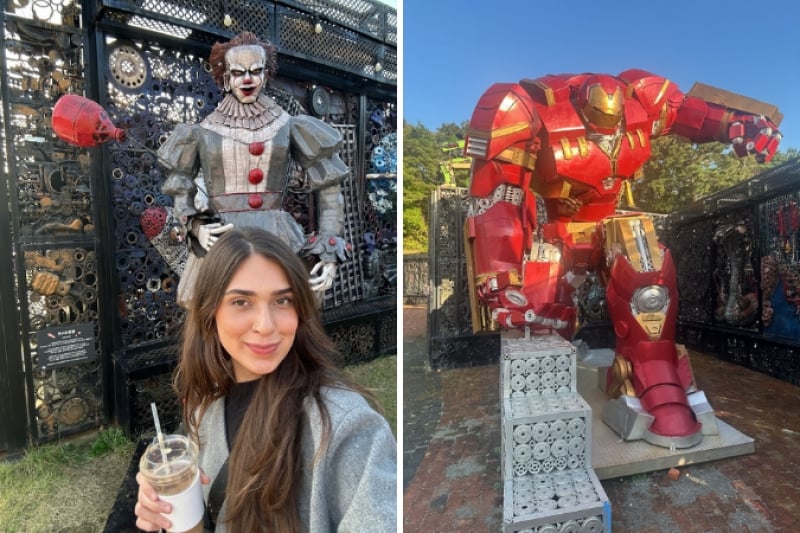
Kim Hoo Cheol might not ring a bell, but he’s the mastermind behind the striking artwork at our next destination, the FE01 Upcycled Complex Cultural Space. True to the name, all 1,200 of his pieces are crafted from recycled FE (iron scraps). His creations range from Iron Man to dinosaurs, proving there’s no limit to what can be built from discarded metal!
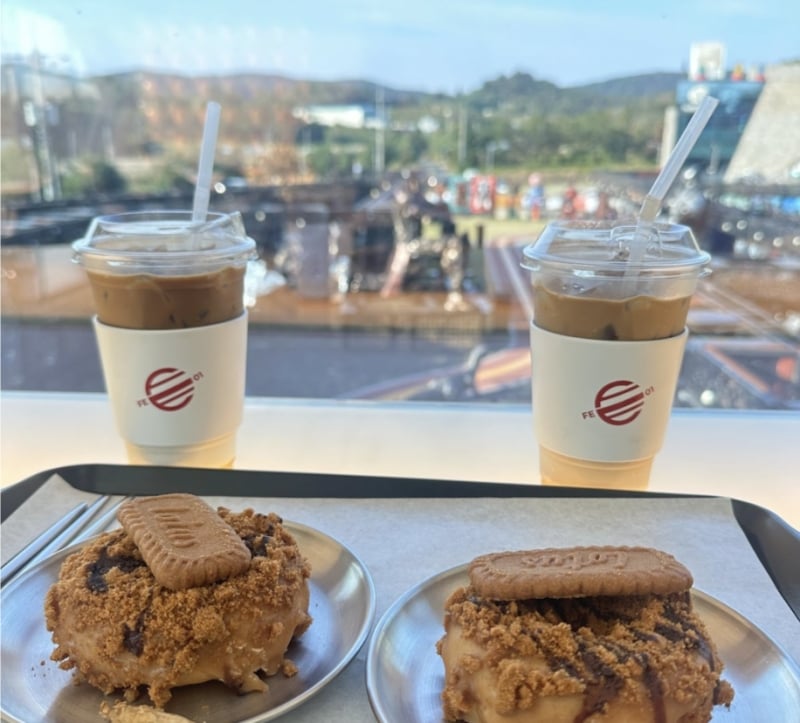
TripZilla Tip: Head to the café on the second floor for delicious donuts, coffee, and more, all while enjoying a stunning view of the attraction!
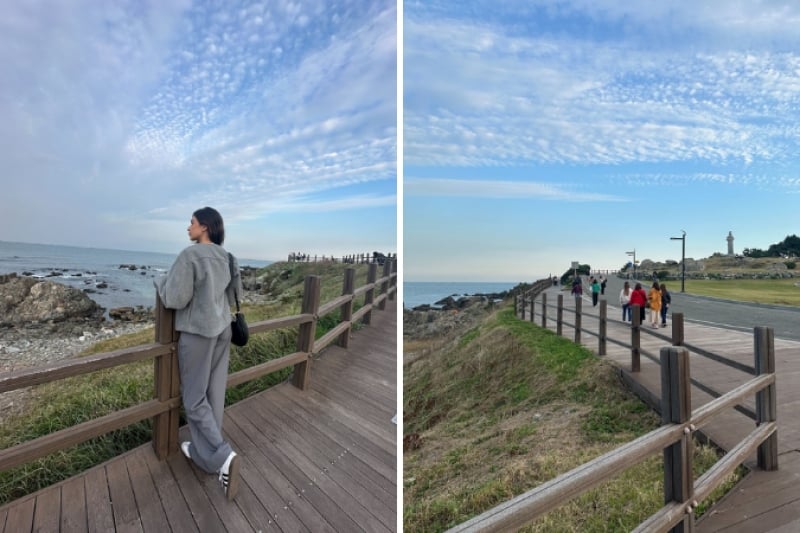
We then made our way to Ganjeolgot, renowned as the first place in Korea to catch the sunrise each morning. While we weren’t there at sunrise, we couldn’t help but marvel at the stunning coastal views. Ganjeolgot Cape also hosts the annual New Year’s Sunrise Festival, where visitors gather to welcome the new year with live performances that last through the night.
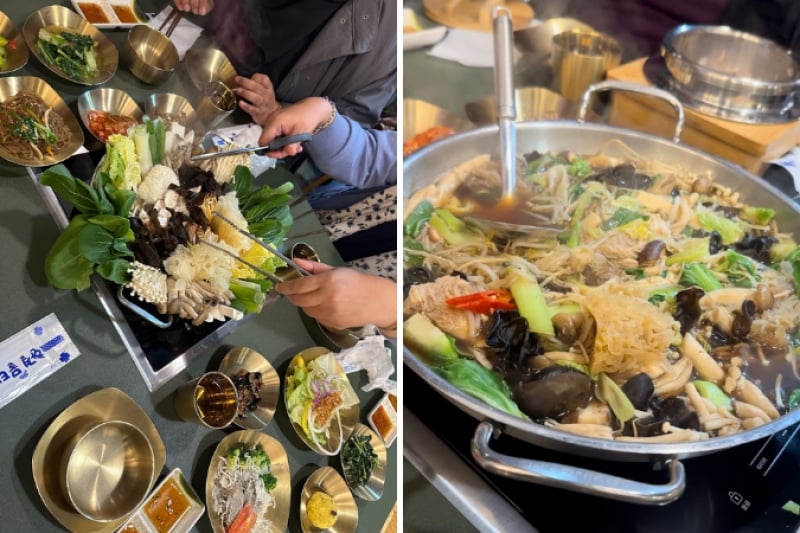
For dinner, we had a choice of vegetarian or pork sotbap, rice served in a sizzling stone pot, at Manpasikjjok. This is actually two dishes combined in one! Let your leftover rice stick to the bottom of the hot stone pot, then add water or tea, and voilà — you’ve got nurungbap (scorched tea rice)!
We ended the day at Lotte Hotel Ulsan, a comfortable and modern retreat in the heart of the city.
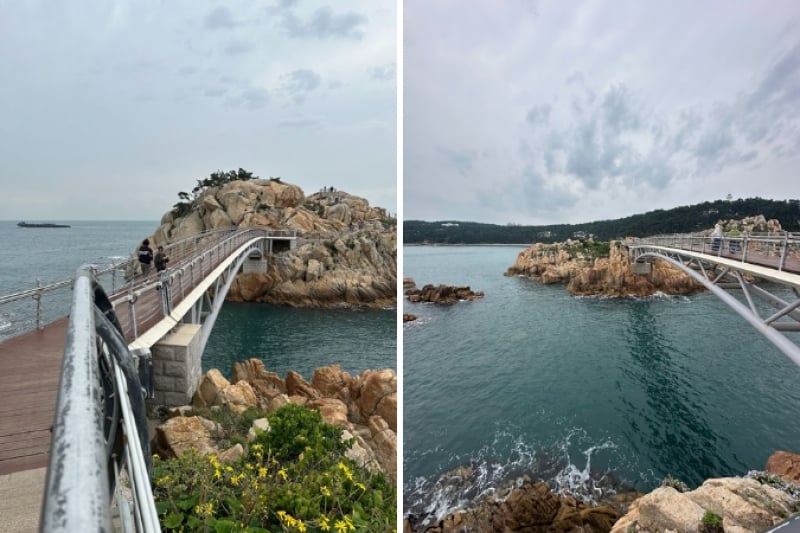
We had a hearty intercontinental buffet breakfast before the first stop of our second day at Daewangam Park — a scenic coastal park where visitors can enjoy walking trails, clear air, and beautiful views of the sea from the suspension bridge. The park is perfect for a relaxing stroll or a peaceful picnic, offering an escape from the industrial areas of the city.
TripZilla Tip: To keep your shoes spotless during your visit, use the air hoses at the park entrance to blow off any dust and debris!
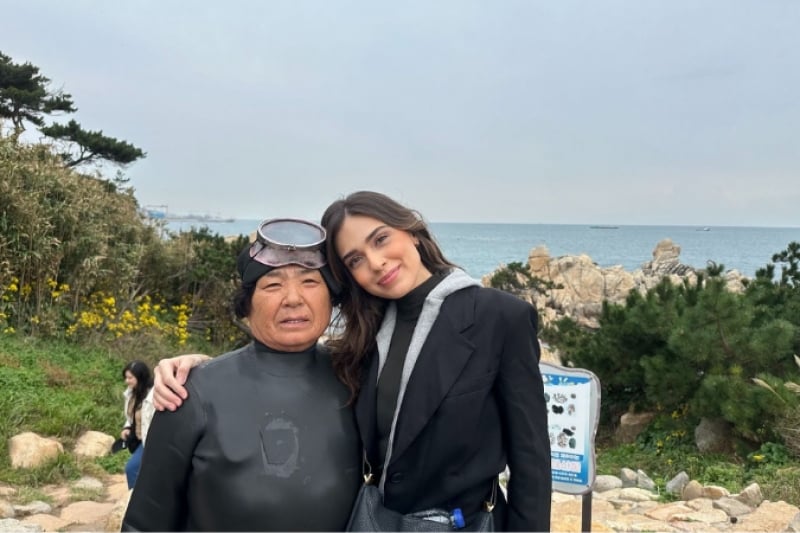
We were in awe of the remarkable fitness of the locals in Korea, from the elderly residents exercising in the fitness corners to the legendary haenyeo — the fearless female divers of the sea. We had the privilege of meeting haenyeo aged 65 to 85, and their strength and resilience were truly inspiring.
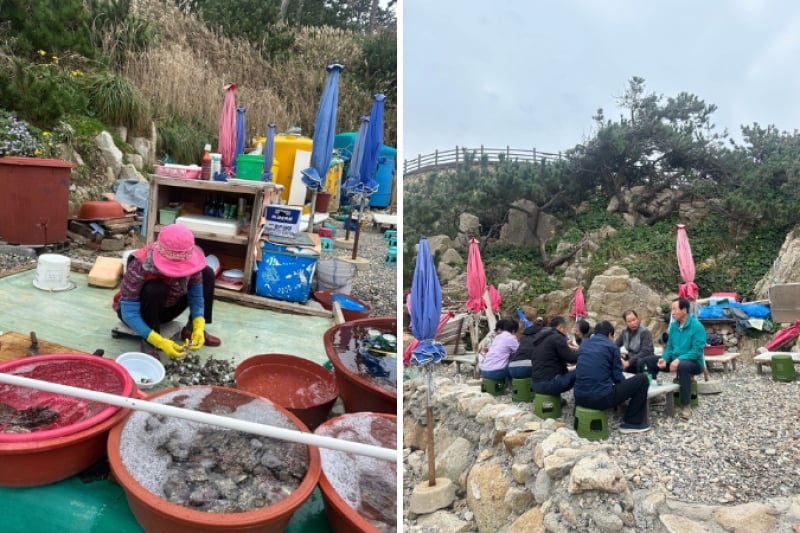
These incredible women are famous for their sea diving skills, diving deep into the ocean to catch seafood without the aid of breathing equipment. Their craft has been passed down through generations, and they continue to sell their fresh catch, showcasing not only their physical prowess but also their deep connection to the sea. When visiting Daewangam Park, be sure to savour their freshly caught seafood while soaking in the breathtaking views of the ocean.
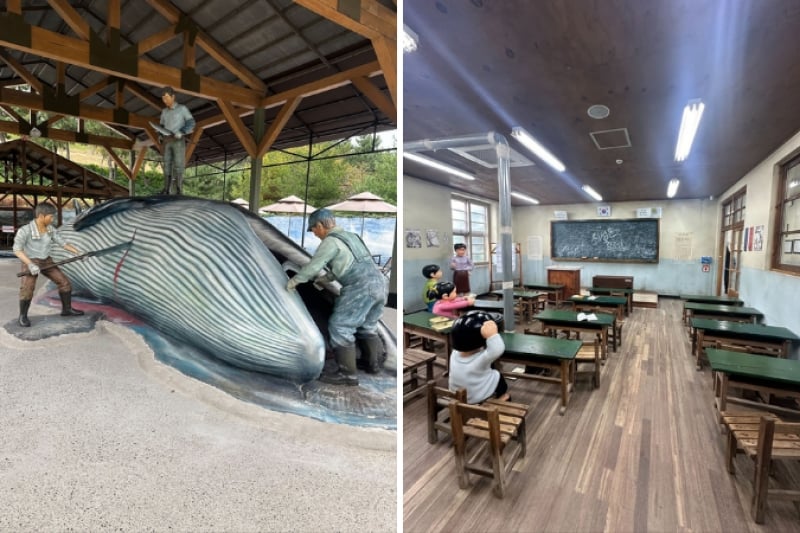
For a deeper dive into Ulsan’s cultural history, we visited the Jangsaengpo Whale Museum. While hunting whales is no longer legal, the museum offers a glimpse into life in a village where whales were once hunted.
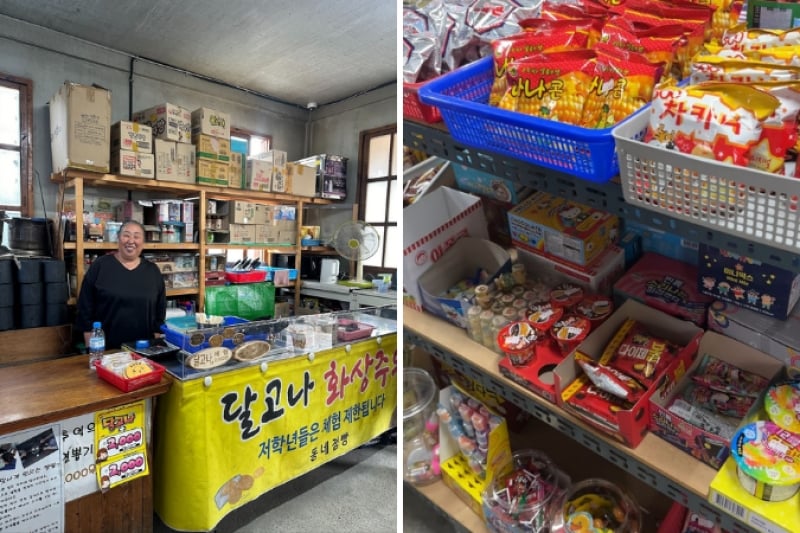
There was a nostalgic convenience store stocked with old-school snacks (including Squid Game’s beloved dalgona), and we even tried pumping water from a traditional well!
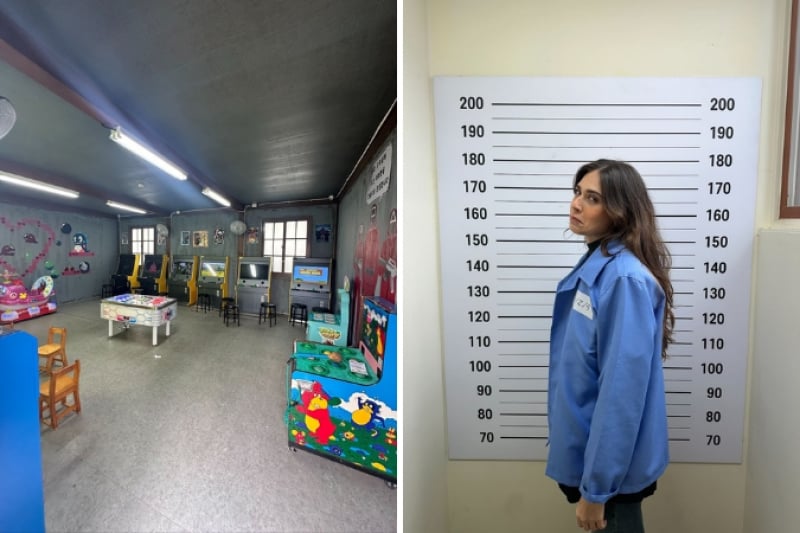
There was a game room and an old police station where we had the chance to try on a prisoner’s uniform and even step inside a jail cell. Jangsaengpo Whale Museum offers countless photo opportunities, making it a haven for photography enthusiasts. Step back in time with a variety of period costumes and meticulously designed backdrops that capture the essence of the era.
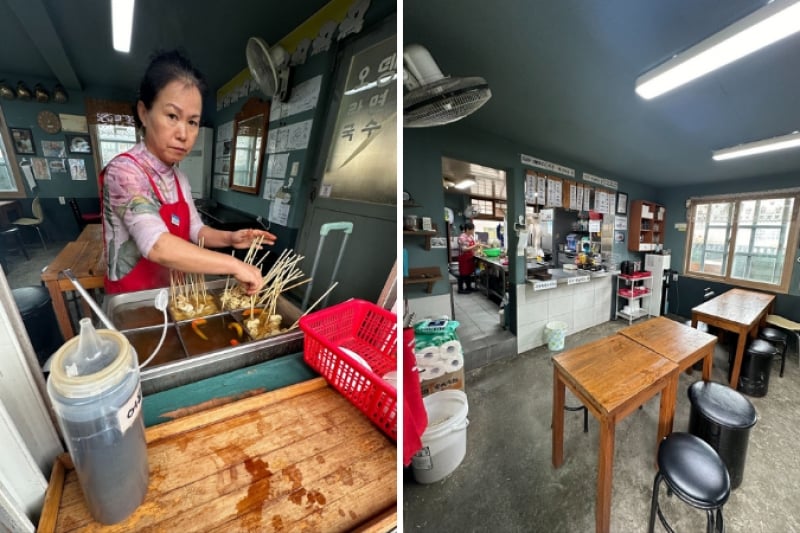
At first glance, we mistook this stall for one of the attractions, with its charming old-school coffee shop vibe. To our surprise, it turned out to be an actual shop offering snacks and drinks!
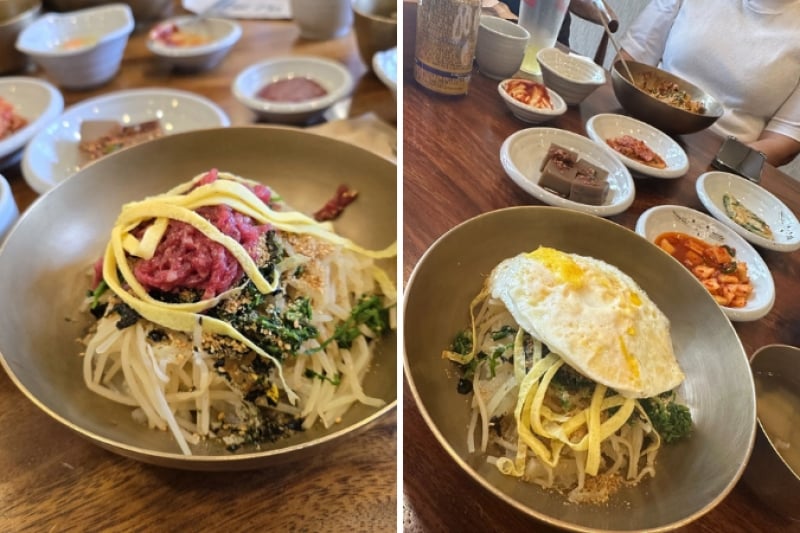
For lunch, we enjoyed a delicious bowl of bibimbap, with the option to try whale meat for those curious about unique flavours. If a beefy, seafood taste intrigues you, we highly recommend giving it a try at Hamyangjip!
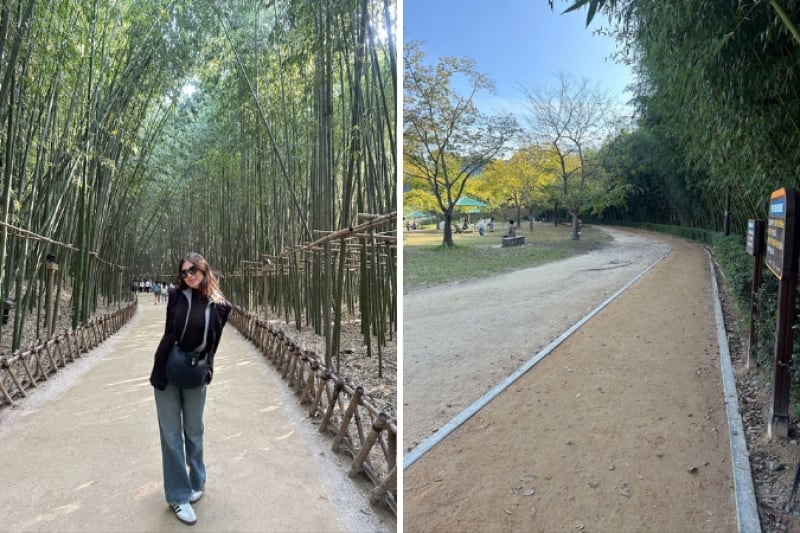
Barefoot trail (R)
We stopped by Simni Bamboo Grove, where we enjoyed a peaceful, free walk through a serene bamboo forest. There is also a barefoot trail designed to help improve blood circulation, offering a natural reflexology experience!
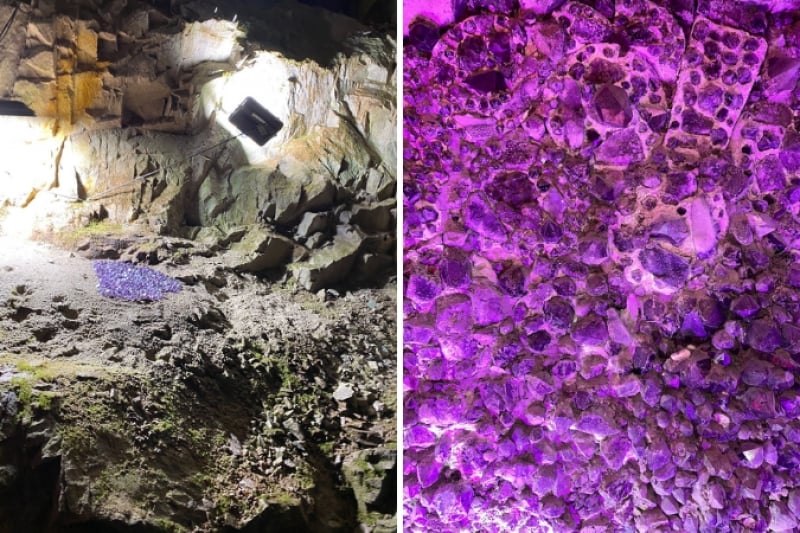
Our next stop was the Amethyst Cavern Park, Korea’s largest man-made cave attraction. We took a boat ride and went on a walking tour through caves lined with amethyst stones.
TripZilla Tip: Make sure to go with someone who understands Korean or have your translation app ready, as all the signs are in Korean!
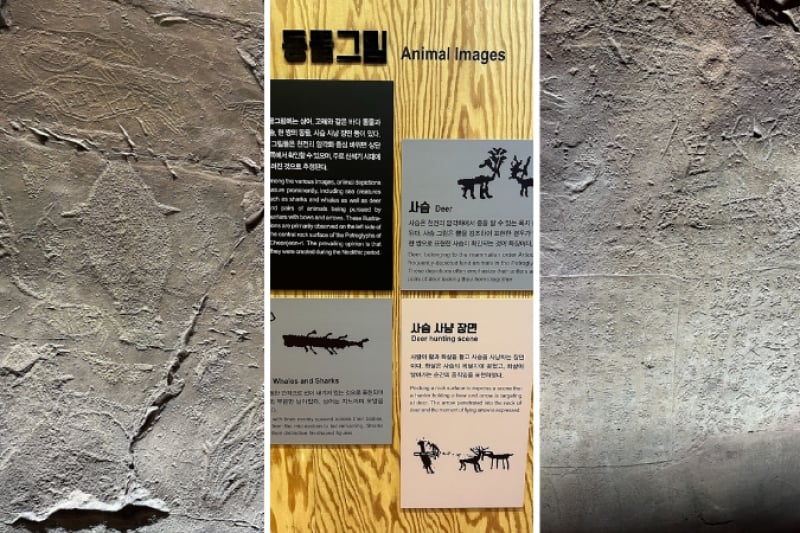
The rock exploration didn’t stop there, we continued our journey at the Petroglyphs of Bangudae Terrace. We caught a captivating glimpse into the lives of the early inhabitants of Korea through 200 ancient carvings, including hunting scenes and depictions of animals!
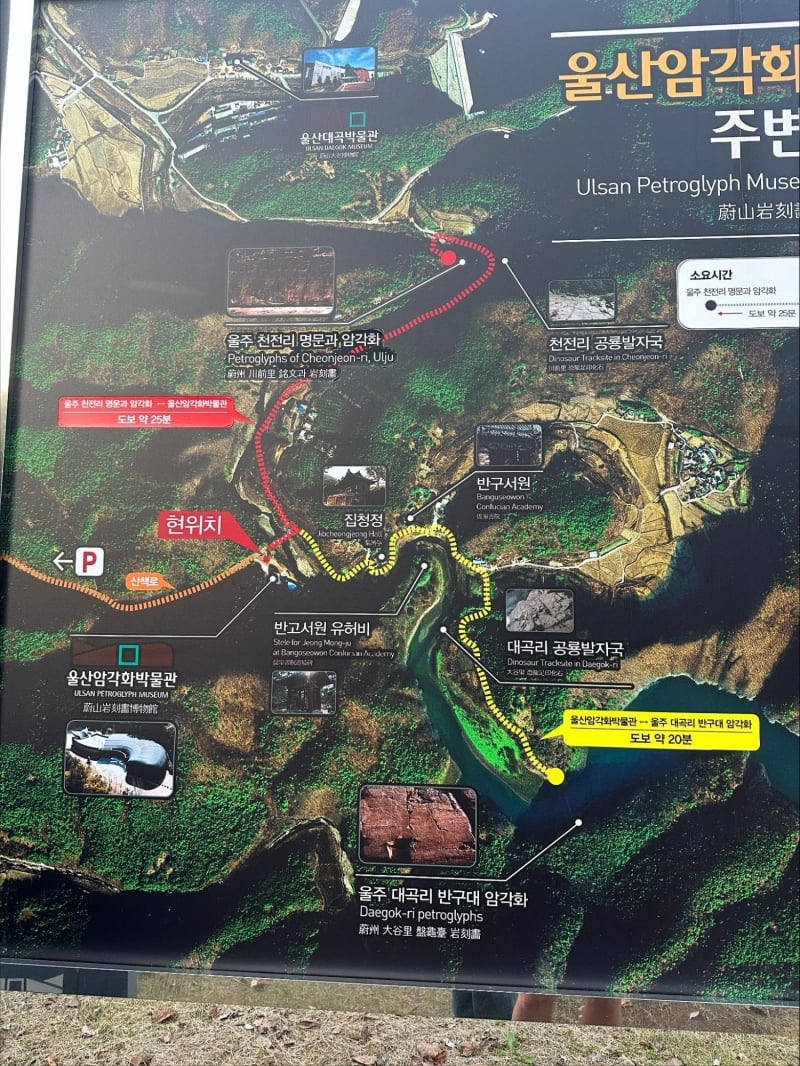
Here is a map for the routes you can take to view the actual Petroglyphs!
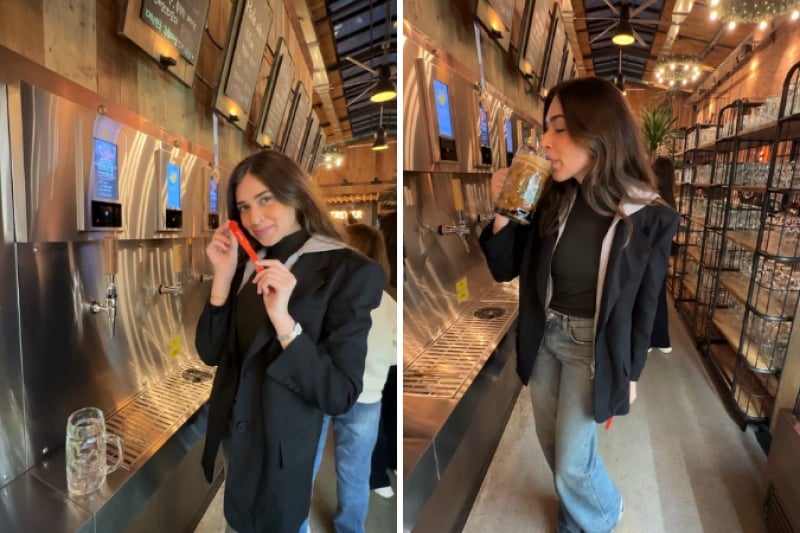
Dinner was at Trevier Brewing Company, where we had the chance to choose from a row of award-winning draft beers and even dispense the beer ourselves! Whether you prefer bitter or sweet flavours, there was a beer to suit everyone’s taste. We were handed a tag to select our beers — just tap it against your chosen brew and pour exactly as much as you’d like. While Koreans often pair their beer with chicken, we opted for equally delicious pizza to accompany our craft brews—a delightful change of pace from traditional Korean cuisine.
As our Ulsan adventures came to a close, we returned to the comfort of Lotte Hotel Ulsan, reflecting on the incredible sights and rich glimpses into the past. Ulsan, you’ve been an unforgettable journey — one that will forever hold a special place in our hearts!
Busan: A coastal adventure of art, cuisine, and natural wonders
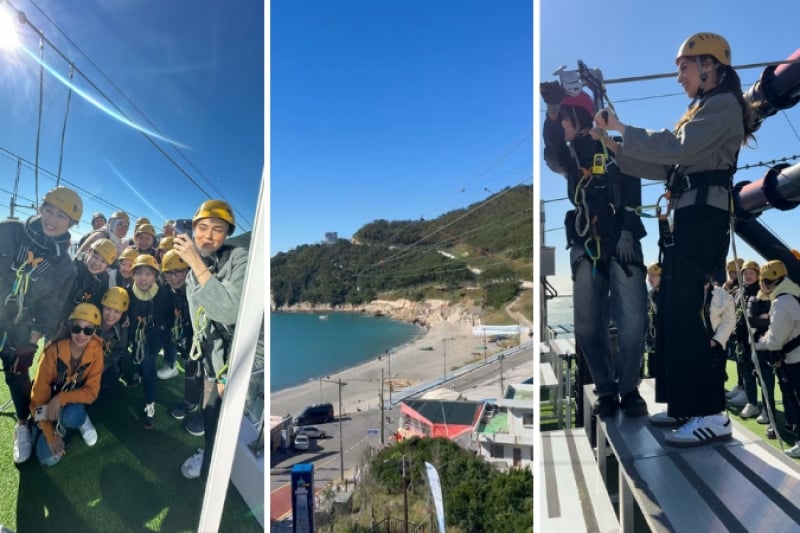
The next morning, after checking out, we set off for Busan Metropolitan City—a dynamic coastal gem famed for its picturesque beaches, rich cultural scene, and thrilling outdoor adventures. Our Busan escapade kicked off with an adrenaline-pumping zipline ride over the dramatic Taejongdae Cliffed Coast. The panoramic views from above were absolutely breathtaking, setting the tone for an unforgettable day!
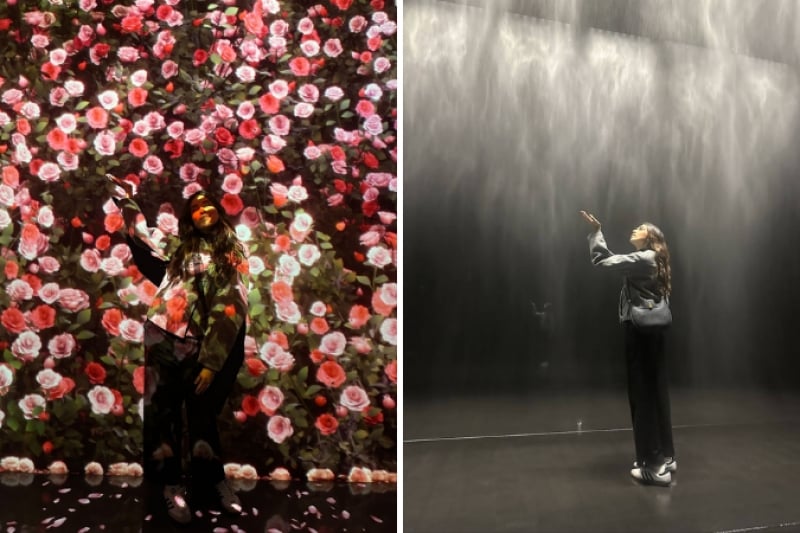
Our next stop was the ARTE MUSEUM in Busan, an immersive media art space. With 16 new, Busan-specific installations, the museum features flowing visuals, dynamic lighting, and captivating soundscapes that transport visitors into a world where nature and art meld seamlessly.

One of the highlights was colouring an animal on paper, scanning it, and then watching it come to life on the screen!
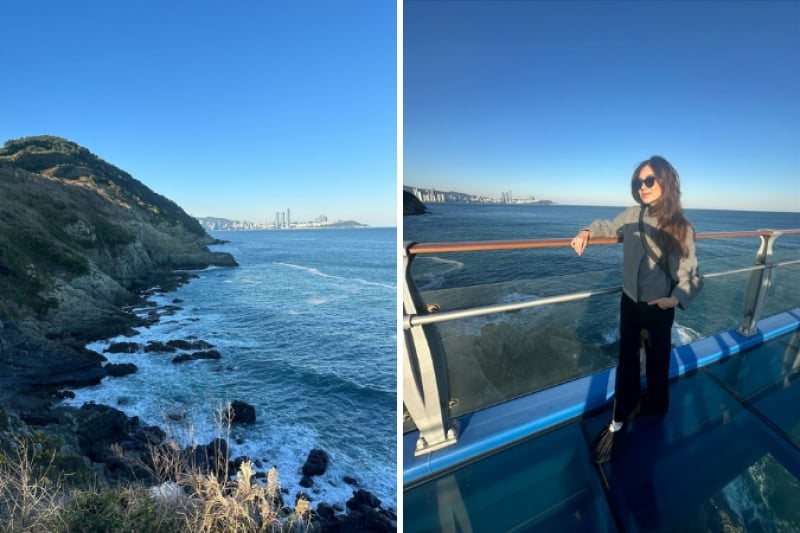
After the aesthetic and fun museum, we headed to Oryukdo Island Skywalk where we were given shoe covers to protect the glass walkway. This glass-bottomed walkway offered an exhilarating view straight down to the crashing waves below — definitely not for the faint-hearted! Best of all, entry is free, making it an unforgettable experience that doesn’t cost a dime (or won in this case).
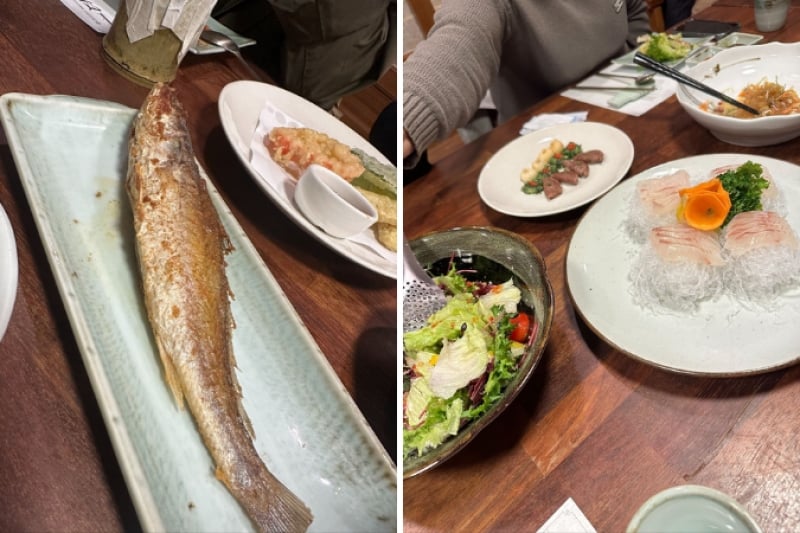
Before we knew it, it was time for dinner at Daon Yakseon Korean Table d’hôte, where we indulged in a 10-course meal! The flavours were delicious and satisfying, with each dish highlighting local ingredients and traditional cooking techniques that made us feel both at home and immersed in Korean culture.
After dinner, we checked into L7 Haeundae by LOTTE, a comfortable retreat for unwinding and recharging for the adventures ahead.
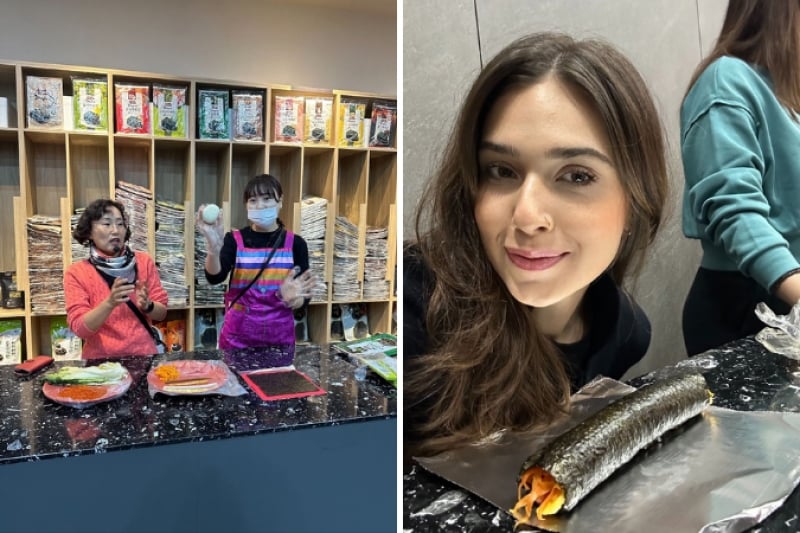
Our second day in Busan began with a unique school experience at Kimchi School, where we got hands-on with two of Korea’s most beloved dishes: kimchi and kimbap. Guided by expert instructors, we gloved up and dove right in. I chose to make kimbap, rolling up the rice, adding sesame oil, and cutting it into perfect slices — easy and delicious!
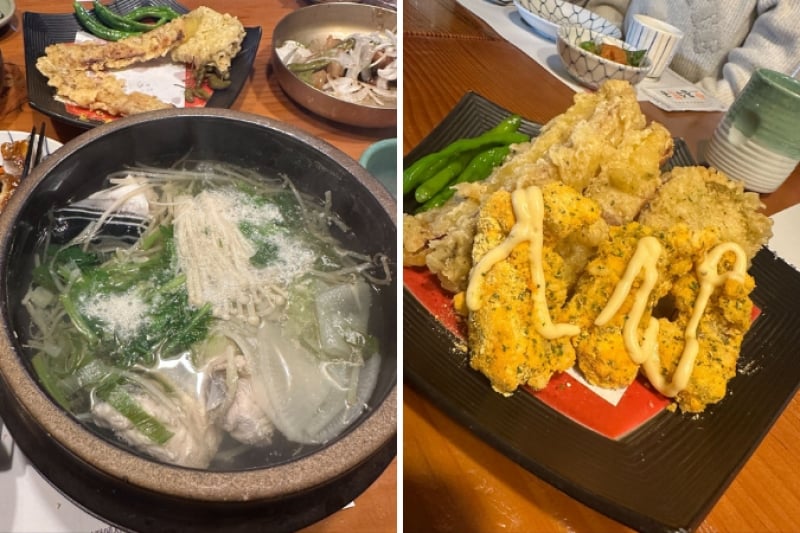
You can never have too much food in Korea, so after our kimbap snack, we made our way to Geumsubokguk, a Michelin Guide restaurant famous for its bok kuk — puffer fish soup. While I wasn’t the biggest fan of the soup, I thoroughly enjoyed the other pufferfish dishes such as the fried pufferfish. Its crispy texture reminded me of a perfect serving of fish and chips!
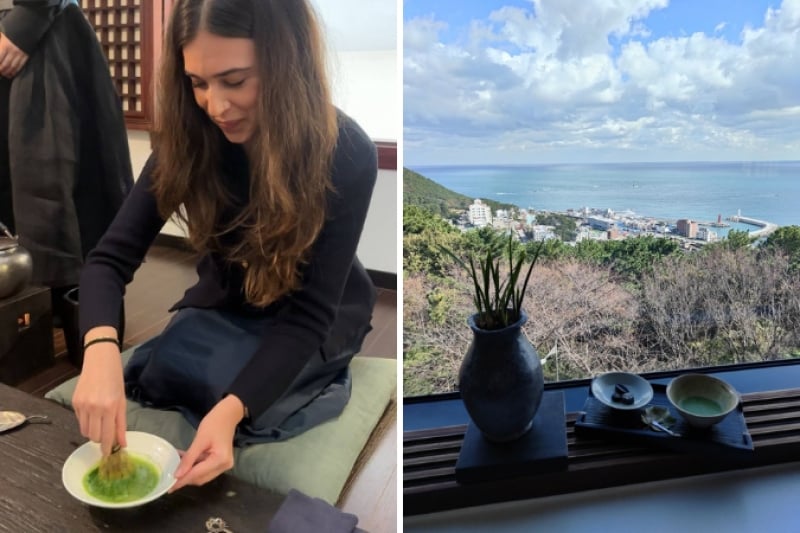
What comes after snack and lunch? Of course, it’s tea time! We tried making tea the traditional way at Bibibidang, and let me tell you — it wasn’t as easy as it looked. The tea masters adhered to a precise process, from heating the water to exactly 90 degrees to the subtlety of their body language. Every step required attention and care, deepening our appreciation of the art of tea-making! We used exquisite tea bowls, some of which were made during the Joseon and Goryeo dynasties, dating back to the 16th and 17th centuries. The oldest bowl we encountered was an incredible 800-year-old bowl, a true testament to the enduring legacy of Korean craftsmanship.
Fun fact: Korean tea culture has been around since the 4th century and was originally enjoyed by monks and nobles. Now that’s some VIP tea!
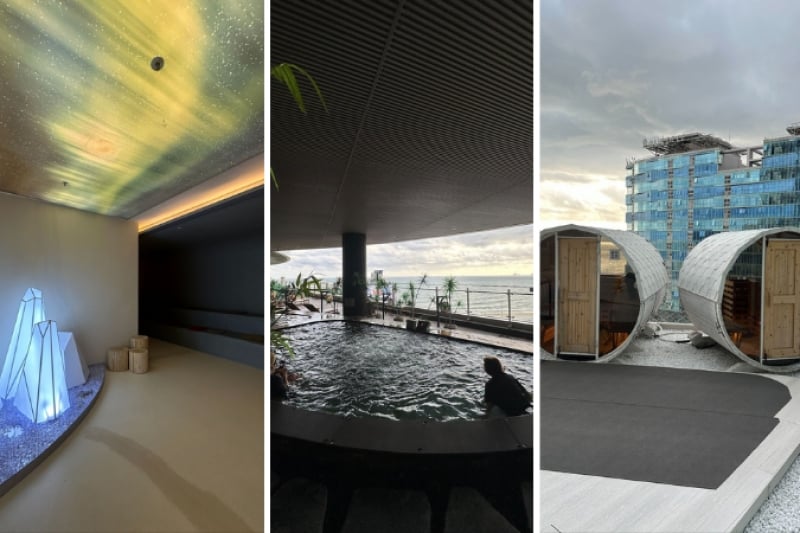
Our next stop was CLUBD OASIS, Busan’s first and only urban wellness hot spring with mineral-rich waters drawn from Haeundae Hot Springs. From the stone spa to the ice room, dry sauna, outdoor hot springs, and walking foot bath, it was the ultimate relaxation experience. This spa was truly the perfect break from all the feasting… but, of course, it wasn’t long before we were back to food.
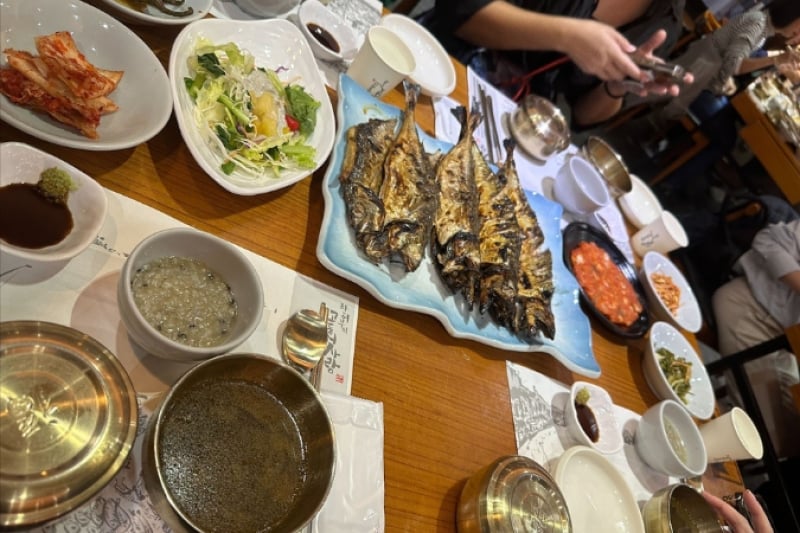
Dinner took us to Fisherman’s Love for Mackerel, where we enjoyed a delicious oven-grilled mackerel, seasoned and cooked to perfection. The flavours were fresh and hearty, bringing the taste of the sea directly to our plates.
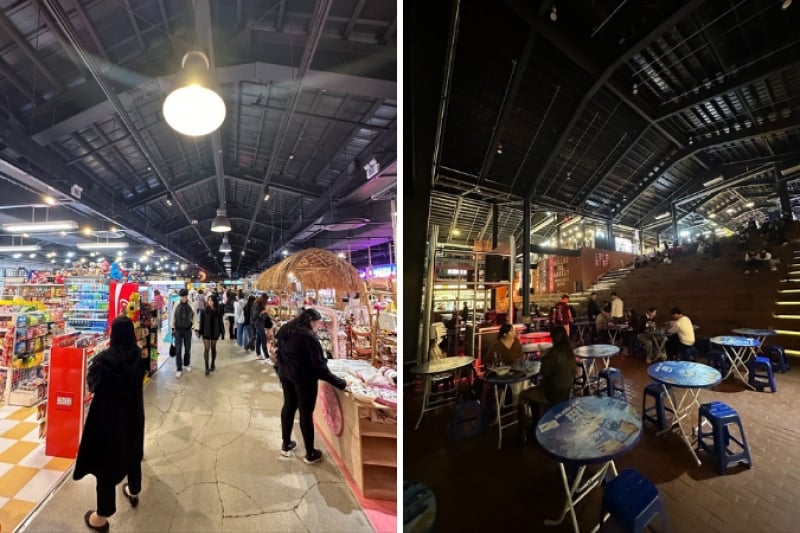
Our final stop of the day was at Millac the Market, where we were greeted with a vibrant blend of restaurants, cafés, clothing stores, and jewellery boutiques. If I had to describe it, I’d say it’s like a more upscale version of Bugis Street in Singapore — it’s the kind of place where time just flies as you browse.
With full hearts and stomachs, we returned to L7 Haeundae by LOTTE where we retired for the night.
Gimhae: A glimpse into Korea’s royal past
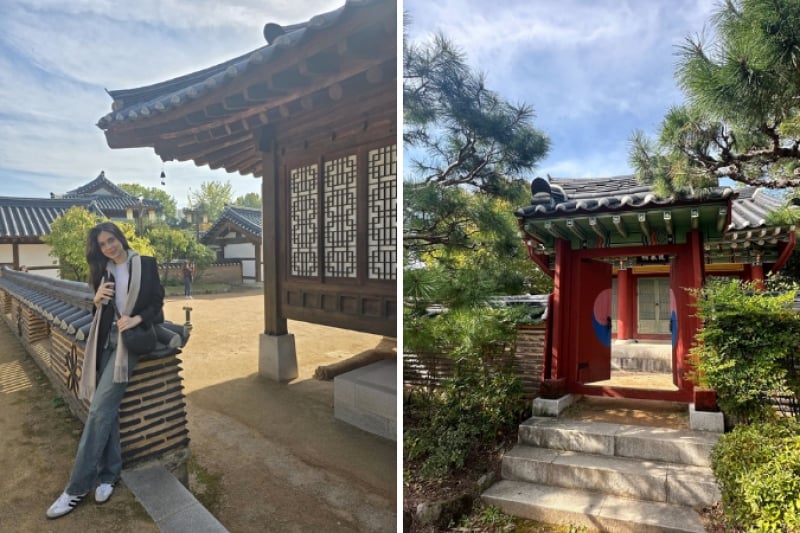
The hanok in this area are for ancestors, no one is allowed to stay or enter (R)
We kicked off the Gimhae leg of our trip at the Gimhae Hanok Experience Center, which is more than just a museum — you can actually stay here! The centre features two types of traditional houses: the commoner’s hanok with a stone roof and the more elegant tiled-roof hanok, reserved for the nobility. The space is designed with four distinct sections — separate areas where men, women, and children resided, following their traditional customs.
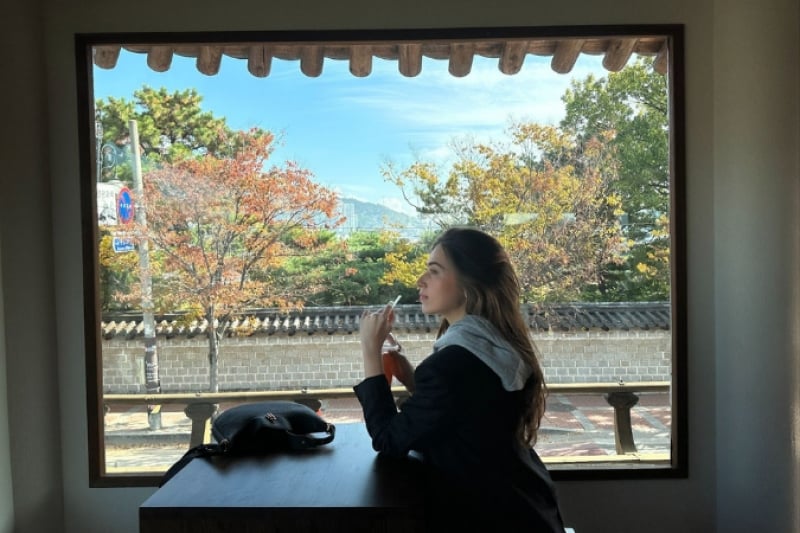
Be sure to visit their café and head up to the second floor, where you can enjoy a stunning backdrop offering a beautiful view of the autumn landscape.
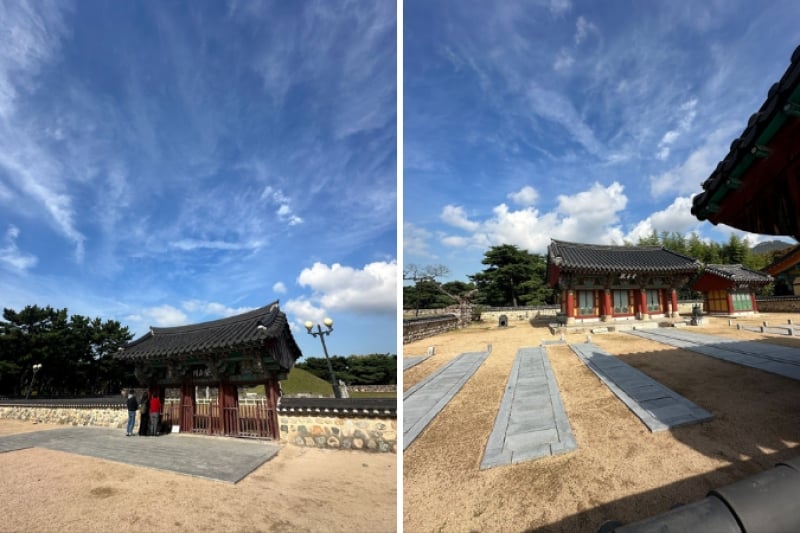
The locals worshipping King Suro (L), who is buried in front of that gate where ceremonies are usually held (R)
Continuing our exploration of the past, we visited the Tomb of King Suro, dating back to the 5th century. This site is not only a historical landmark but also a place of respect for the locals, with certain sections of the tomb accessible only during specific ceremonies. If you’re planning a visit, it’s worth checking for any special events to experience the full cultural atmosphere.
Fun fact: King Suro tied the knot at just 6 years old with his queen, who was 16 years old!
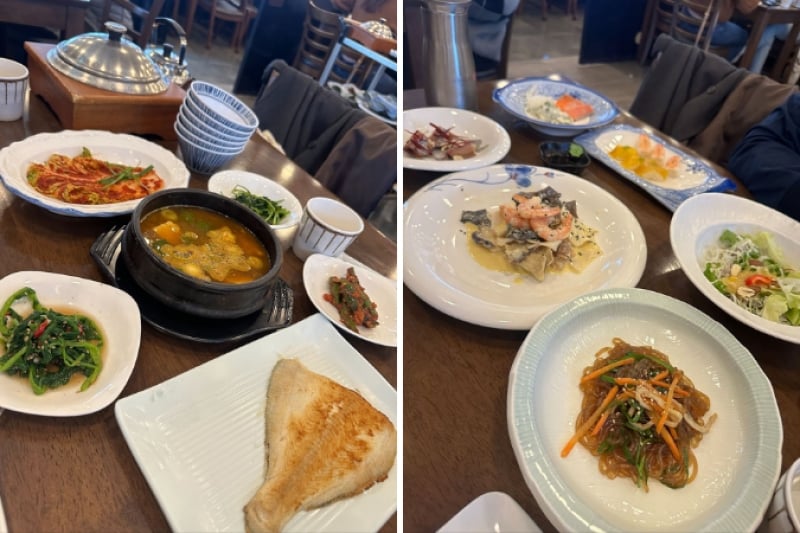
For dinner, we made our way to Surassang and savoured hanjeongsik once again, this time with a new and delightful array of flavours and dishes.
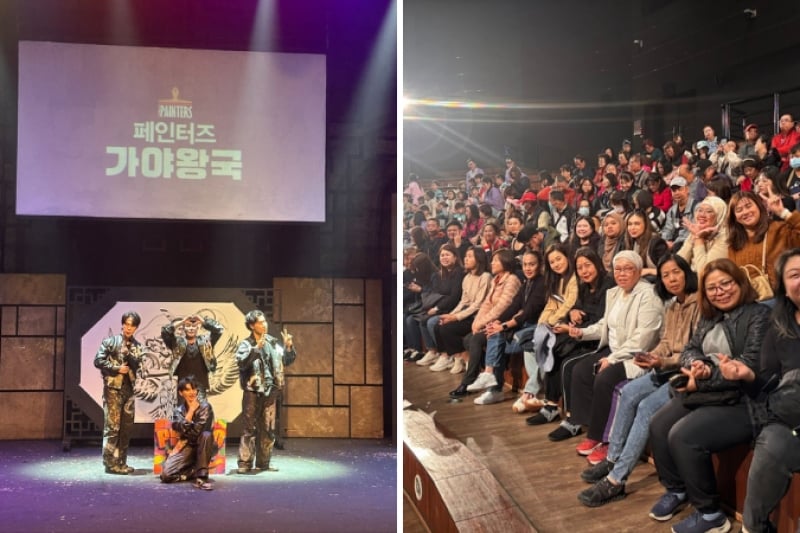
Gimhae is also home to the Gimhae Gaya History Park, dedicated to the ancient Gaya Confederacy, which ruled the region before the formation of the Three Kingdoms of Korea. The park offers captivating educational performances that bring to life the remarkable story of King Suro and his queen. Visitors can also be dazzled by the creative artistry of The Painters, a talented group that fuses dance, art, and martial arts into a dynamic and unforgettable show. It’s an experience that promises to enchant visitors of all ages!
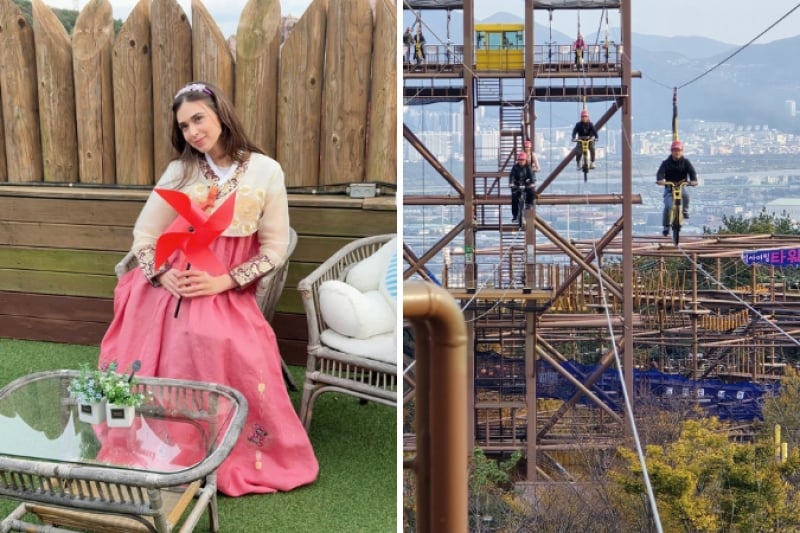
Be sure to explore every corner of the park, as there’s an abundance of sights and activities to enjoy! You can even rent a hanbok and stroll through the park, capturing beautiful photos along the way! For a touch of adventure, try ziplining or rail biking — either option offers incredible views that will take your breath away!
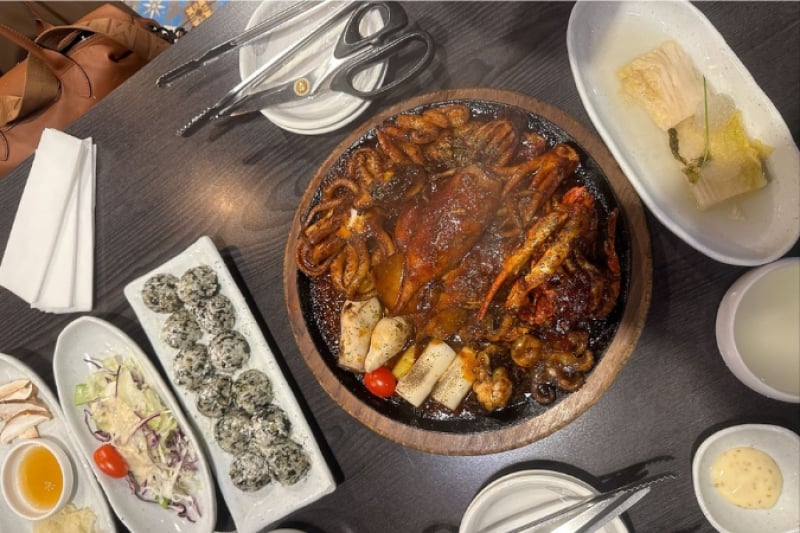
We ended our day with dinner at Sikdang 3 Sun where we had the chance to try haemul cheolpan gui — seafood teppanyaki, or saeng modeum gui — assorted grilled meat. Throughout our trip, the seafood consistently impressed us with its freshness, highlighting the region’s coastal richness. The seafood teppanyaki was no exception, perfectly grilled and seasoned, an absolute delight!
Our final night was spent back at L7 Haeundae by LOTTE and we were already reminiscing about the incredible experiences we’d had.
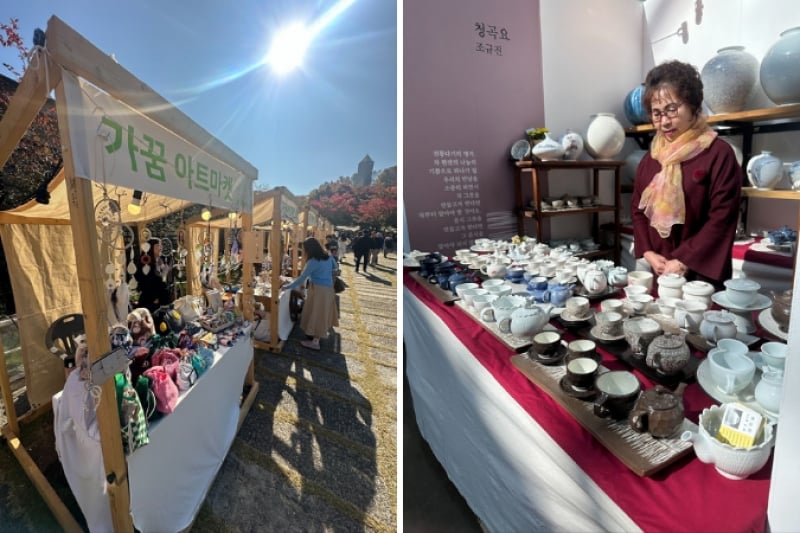
The last day had a shorter itinerary and it was hard to believe that our trip was coming to an end. We visited the Gimhae Buncheong Ceramics Festival, a celebration of buncheongsagi, celadon with a blue-green tone. It was a great opportunity to pick up some last-minute trinkets and souvenirs!
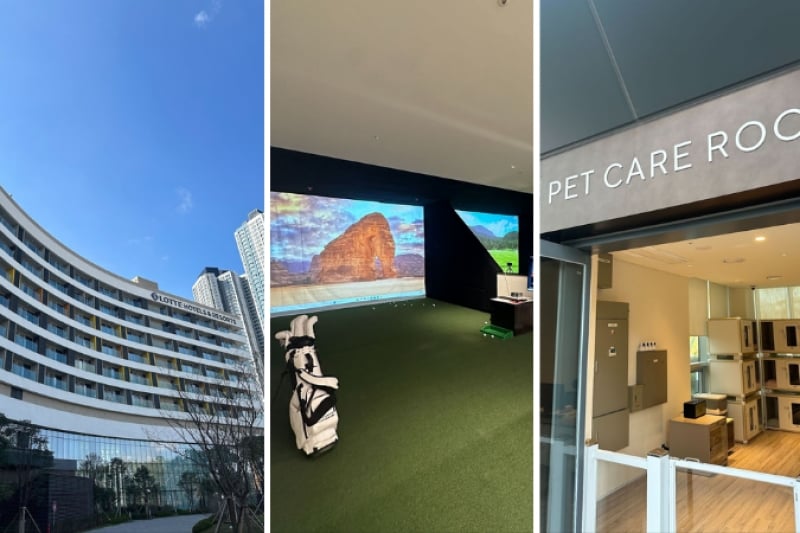
We headed to the Lotte Hotel & Resort Gimhae, but sadly, not to check in this time. Our tour of the newly-opened hotel left us thoroughly impressed by its sleek architecture, welcoming atmosphere, and top-notch amenities.
Families will love the thrilling water park and Tic Toc Island — where kids can enjoy a sprawling ball pit and climbing zone. For foodies, the resort is a paradise with diverse dining options, including a sumptuous buffet, authentic Chinese cuisine, a bakery café and a glamping BBQ experience for an extra-special meal under the stars. Wellness seekers can unwind at the fitness centre, swimming pool and sauna, while active travellers enjoy a match on the outdoor tennis courts or test their skills with screen tennis and screen golf.
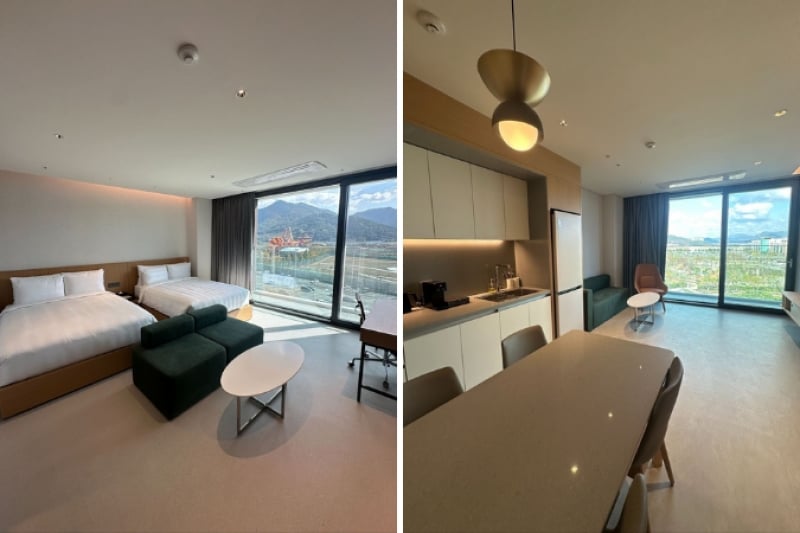
Family room (L) and Suite room (R)
Fun fact: The hotel is pet-friendly, so your furry friends can join the adventure too!
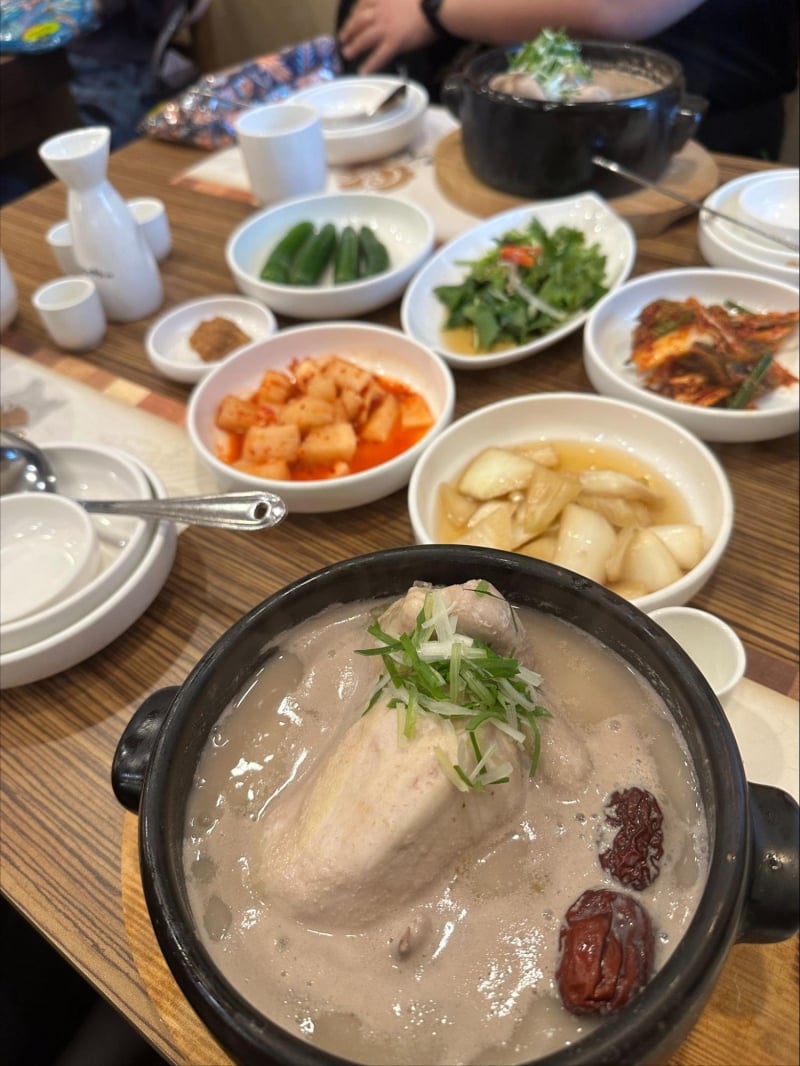
Lunch at Gabo Samgyetang was without a doubt, my favourite meal of the entire trip. Their famous Jeonbuk Samgyetang — a comforting abalone ginseng chicken soup — was a standout for its rich, flavourful broth and tender chicken stuffed with perfectly cooked rice. The harmonious blend of ingredients created a deeply satisfying meal that left a lasting impression. This hearty dish not only nourished me but also kept me full and content through the flight home, making it an unforgettable highlight of my culinary journey!
Also read: Exploring Gyeongsangbuk-do: Hidden Gems for Your Next Trip to South Korea
With heavy hearts, we took our final bus ride back to Gimhae Airport. As we headed to the airport, it was clear that BuUlGyeong had offered more than just stunning sights — it gave us a deeper connection to Korea’s rich history, culture, and, of course, amazing food. Though it was time to say goodbye, the memories we made would stay with us long after the trip ended, leaving us already dreaming of our next adventure in Korea.
|
Has Gyeongnam captured your heart yet? Whether you’re planning a quick day trip or a full getaway like we did, this region offers an unforgettable mix of history, culture, breathtaking scenery, and mouthwatering local cuisine. From exploring hidden gems to immersing yourself in peaceful landscapes and unique traditions, Gyeongnam has something for everyone! Ready to experience these lesser-known but incredibly rewarding parts of Korea? For more information and to help plan your itinerary, get in touch with the Korea Tourism Organization (KTO) and start crafting the perfect trip to this charming region that is sure to leave lasting memories. |
A special thanks to Korea Tourism Organization for inviting us on such a wonderful trip!
All images are credited to Praveena




